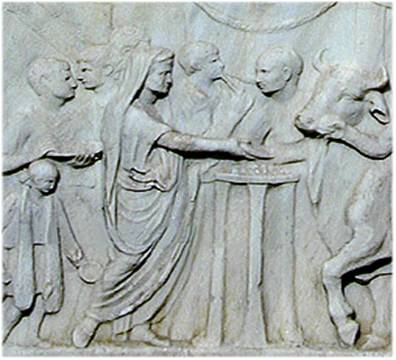|
BRIEF CHRONOLOGY.
Although a form of the toga [Tebena] appears
in Etruscan times it wasn’t the garment we associate with the
Romans. Merely an oblong of cloth that got used as a tunic and blanket,
it was the basic garment for the farmer working in his field: or
his ‘battle dress’ when drafted into the army. Women also
wore a form of toga, but she also had a ‘dress’.
It was only afterwards that it metamorphosed into the - much-despised
- formal dress item. It never seems to have been a popular thing
to wear.
The Republican Toga.
By the second century B.C., the toga had, with the two exceptions
noted, become an item of purely male dress, and was worn over a
tunica: the tunica fell to mid-lower calf length. It had a rounded
lower edge and a small over-fold [Sinus] at the top. This form seems
to have continued in use until well into Imperial times.
Late 1st to early 2nd century A.D.
During this period, the toga developed into a much larger garment;
some 5 metres long, which could no longer be put on alone. You needed
at least two others to help. To cater for this the shape changed
to a roughly trapezoidal form for the sinus area over a semi-circular
form at the bottom. Quintillion (late 1st century) goes to some
length about the correct way to wear one for oratory:-
“In my opinion the Toga should be rounded and cut to fit
if it is not to be unshapely. The front edge should reach the middle
of the shin whilst the back should be somewhat higher...the sinus
should
fall to a little above the edge of the tunica if it is to be the
most becoming, it should not fall below it. That part that passes
like a belt from under the right arm to over the left shoulder should
be neither too tight nor too loose. The portion that is last to
be arranged
should sit rather low, since it will sit better thus and may
be kept in place. A part of the tunica should be drawn back in order
that it may not fall over the arm when we are pleading, and the
sinus should be thrown back over the shoulder, while it will not
be unbecoming if the edge is turned back.”
Early 2nd to early 3rd century.
There seem to have been some relatively minor changes to the way
it was worn and the sinus came to be longer – further towards
the calf than previously – and a different way of wearing came
into use. From the Trajianic relief’s it looks as if the fold
coming under the right arm to the over the left shoulder (balteus)
was folded tighter. This went under the part hanging over the left
shoulder. The Umbo also became exaggerated by an increase in overall
length.
Early to late 3rd century.
The balteus became grossly exaggerated; it was
concertina-folded to form a smooth band and was taken twice around
the body. Much practice in preparing this is required. Thus, I would
think it isn’t a suitable idea for reenactment when we are
frequently short of people and time.
Early 4th century
The style with an exaggerated balteus continued but the sinus also
grew so baggy that if not held on the right arm it swept the ground.
Late toga
After the ’fall’ of the Western empire the toga slowly
changed to a shape akin to a ‘Yale’ type of key. It must
have been easier to put on, cost less and easier to wear.
Notes
"Dress"
: Akin to the Greek Peplos, the so-called ‘tube’ dress.
Mr. Farmer may have worn underpants as his other garment.
"arranged"
: Later known as the umbo
|

